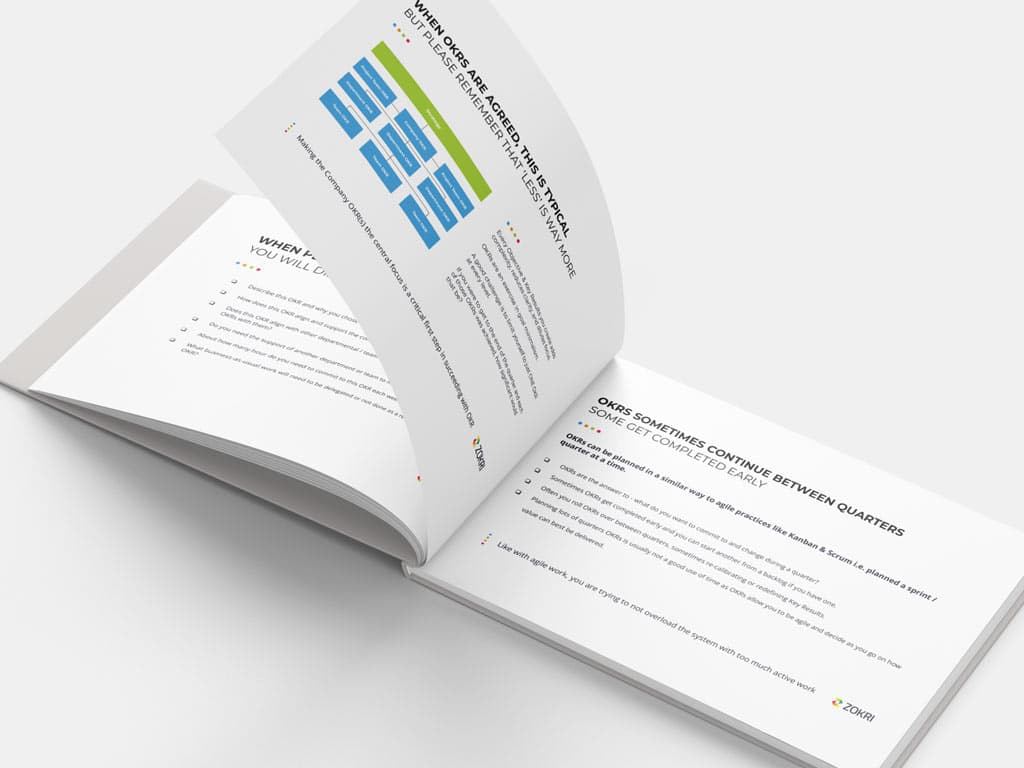Economy has always been a constantly changing mindset executed under a certain regulatory framework. However, over the past 20 years transformation cycles sped up tremendously. The main driver is a steady but volatile globalization process, which is increasingly based on network structures and digital connectivity.
Agile and dynamic strategic management of organizations is key to remain a part of modern market environment. Besides, bringing this mindset into company’s culture and thus in every employee’s daily business is the second column a sustainable future-success-story should be built on. Objectives and Key Results (OKRs) as a management framework offers companies exactly that: combining the overall strategic picture with intrinsic commitment in day-to-day business.
What are OKRs?
The roots of the concept behind OKRs reach back to the mid of the 20th century and consequently cannot be termed as new. Nevertheless, the framework gives answers to many of the questions companies expect to face in future markets.
Typical challenges in executing on strategy
A company’s strategy brings the underlying ideal of its mission and vision into reality. In theory often clearly defined and well-grounded, transformed into practice it becomes sooner or later obvious what’s key for success: the human factor.
Especially in such short-term and dynamic markets as currently seen and expected in the future, companies’ leadership faces multidimensional challenges related to strategy execution. The OKR-framework provides a holistic approach which offers many answers, if planned, structured, implemented, executed and maintained correctly.
Constant change of regulatory and operational environment
One of the fundamental challenges for companies in almost every industry will be the admission of constant changes and dynamics within and in between markets. According to studies with related focus, more than 70 % of executives expect their current business model under threat within the next 60 months. Geographic movements, climate and environmental challenges, demographic change and technological progress are only a few of the outreaching number of factors which are expected to provoke continuous changing circumstances, companies will have to deal with moving forward.
Agile management frameworks like OKRs offer methods and approaches which enable a flexible and short-term alignment of company’s strategy to external movements and dynamics. With a steady circle-concept, OKRs provide the possibility of evolutionary progress at all organizational levels. Thanks to its holistic approach, the OKR-framework seems to be capable of partial adjustments as well as transformation processes affecting the whole organization.
Unclear strategy prevents orientation and identification
To face current and future market dynamics, the actual mission statement as well as the future-oriented vision should be clearly defined and understood.
But studies related to the topic show the following results:
- A distinct majority of the employees have no clear understanding of their company’s strategy.
- Although 3 out of 4 business leaders consider agile execution of strategy as one of their top priorities, less than 1 of 10 companies has an agile management approach fully operational implemented.
The first step of OKR-implementation is to clearly define the company’s current strategy. With a common strategic understanding, all employees are on the same page regarding the “why” and “how”. All moving into the same direction towards a common goal gives orientation for the individual within the complex overall structure.
Due to its intrinsic approach through all organizational levels, OKRs help to find the individual effort prospering the big picture. The deeper knowledge might strengthen personal commitment and foster identification with the organization’s values and achievements.
Deficient execution of strategy due to lack of leadership
The sustainable success of an agile strategy approach highly depends on strong leadership. The top management needs to be fully convinced and willing to permanently leave the comfort zone of rigid structures and monotone routine. Executing agile strategy approaches requires a self-understanding open mindset, discipline and structure, as well as motivation and commitment.
If these characteristics are not represented in an intense and authentic way, employees will not follow. Around 90 % of companies fail with the successful execution of their strategies. A crucial aspect on the successful implementation of agile strategies is the empowerment of employees within the process. Scientific research and surveys show that the majority of staff claims deficient recognition by their supervisors which might result in uninspired, demotivated and inefficient workforce. OKRs support regular interaction throughout all organizational levels. Transparent and clear strategy communication combined with understandable and interesting tasks encourage staff to get involved.
Moreover, strong leaders give confidence for “learning by doing” or “trial and error”. Being ambitious and innovative is typically built on a healthy culture of failure. The OKR-concept even demands imperfection, as reaching all goals completely means lack of ambitions and agility. Strong leadership in combination with confident, ambitious and empowered employees bring agile strategy management into the company’s culture.
Key considerations when rolling out OKRs
Dynamic markets, decentralized networks and constant interconnectivity with stakeholders changed business and economy fundamentally. Long-term strategies based on passive, risk-averse management behavior have to be replaced by agile and flexible management approaches. Although most of the organizations have recognized this transformation as one of the main challenges, the majority of companies do not succeed when trying to execute their strategy.
Challenges on the way to agile OKR-based strategic management
The decision to start a fundamental company-wide transition from oftentimes wealthy grown and known business strategies towards modern management principles requiring radical changes of mindset, culture and behavior. However, on the way through the transformation process many challenges have to be faced both, on individual and on organizational level.
Lack of confidence and commitment at top management level can be a severe threat for a successful transformation process. The OKR-concept demands constant interaction with colleagues and other stakeholders. Employees need to be actively involved into OKR-philosophy and expect constructive feedback on their action.
Especially during the starting phase, patience will be required from whole staff. Expectations on the OKRs immediate effect might not be realistic. Additionally, the transparent nature and constant communication and interaction requirements might appear challenging for some staff members.
Changes in structure could also affect the individual level. Some job descriptions might noticeably change, including new tasks and responsibilities. To be able to successfully master individual adjustments, employees need to understand in depth the overall picture of transformation as well as the individual role within this strategic concept.
New processes and procedures typically require additional working efforts. Due to its contrary nature, in some cases an alignment of “old” but remaining daily business with new OKR-methodology can be tricky. Especially in consideration of defining appropriate objectives and key results which are balanced well between easy and ambitious.
OKR-framework – strategic benefits in dynamic environments
Should introduction and implementation of an OKR-based management approach succeed, the concept offers various strategic aspects which tap their full potential in dynamic environments, preferably:
- Holistic concept involving all organizational levels
- Transparent approach supports strategy understanding and alignment
- Strong staff-involvement fosters commitment, motivation and teamwork
- Short-term OKR-cycles allow immediate alignment to market movements
- Evolutionary structure with continuous learning process
Besides, an operational OKR-framework provides structure and orientation. Each employee knows exactly which piece of puzzle he or she contributes to the big picture. Constant and frequent feedback-loops promote steady learning and improvement. The constant measure of achievement also supports the allocation of resources, which can be focused on OKRs with the highest priority.
Key factors for successful transformation to OKR-framework
Many organizations currently face disruptive change of economic, political as well as social environments. Most companies recognized these movements and the underlying dynamics. Consequently, holistic transformation of the company’s strategy is a top priority on the to-do-list of many management boards. However, roll-out and execution of modern strategy concepts fail regularly. Looking behind the curtain, a big number of reasons can prevent a successful transformation. On the other hand, three factors are considered key for sustainable execution of a new strategy-concept like OKRs:
- Convinced and committed top management
- Clear understanding of company’s strategy
- Sufficient internal capacities and external support
The implementation of a new strategy concept like OKRs typically affects the whole company, costs a lot of time and binds workforce and capital. Such fundamental changes of a company’s DNA must find full and unconditional support by top management. Otherwise, a successful roll-out is hardly possible. Strong leadership is necessary to sell substantial change to staff.
A second critical factor for the implementation of the OKR-concept is a clear understanding on the “why”. Employees need to understand the overall picture of the company’s guidelines – vision, mission statement and strategy. Moreover, a clear and precise, well understood strategy is usually the starting point for OKR-introduction.
In many cases, sustainable change is based on additional effort and a mix of patience and frustration during the transformation process. To ensure a structured shift into new strategic thinking and behavior, sufficient internal capacities should be available. When we enter green field circumstances, we have neither previous experience nor any expertise with, why don’t we ask someone who already has? Guidance and support of professional advisors might not be the worst decision, considering the fundamental weight and outreach of the underlying challenge.

DOWNLOAD FREE GUIDE TO STRATEGY DELIVERY USING OKRs
Learn how to write and manage OKRs. Discover how to combine Strategic Themes, OKRs, KPIs and Strategic Initiatives to achieve high levels of performance across teams.


